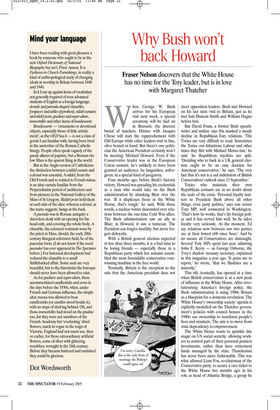Mind your language
I have been reading with great pleasure a book by someone who ought to be in the new Oxford Dictionary of National Biography but isn’t, Peter Anson. It is Fashions in Church Furnishings, in reality a kind of anthropological study of changing ideals in worship in Britain between 1840 and 1940.
In it I ran up against items of vocabulary not generally required of even advanced students of English as a foreign language: dossals and paenula-shaped chasubles, footpaces and tables of prothesis, riddel curtains and riddel posts, gradines and super-altars, immortelles and other items of bondieuserie.
Bondieuserie — ‘ornaments or devotional objects, especially those of little artistic merit’, as the OED has it — is not a class of goods I am familiar with, having been bred in the austerities of the Roman Catholic liturgy. People often speak vaguely of the gaudy allures of papistry, but a Roman rite low Mass is the sparest thing in the world.
But in the Anglo version of Catholicism the distinction between a riddel curtain and a dossal was essential. A riddel, from the Old French and so related to French rideau, is an altar curtain familiar from the Perpendicular period of architecture and from pictures in the National Gallery of the Mass of St Gregory. Riddel posts hold them at each side of the altar, whereas a dossal, as the name suggests, hangs at the back.
A paenula was in Roman antiquity a sleeveless cloak with an opening for the head only, and covering the whole body. A chasuble, the coloured vestment worn by the priest at Mass, should, the early 20thcentury liturgical reformers held, be of the paenular form. (I do not know if the word paenular has ever appeared in The Spectator before.) For historical development had reduced the chasuble to a small fiddlebacked affair. Some such are very beautiful, but to the historicists the baroque should never have been allowed to exist.
As for gradines and super-altars, these accommodated candlesticks and cross in the days before the 1930s, when, under French and German influence, the simple altar mensa was allowed to bear candlesticks (or candles stood beside it), with no steps of shelving behind. Oh, and those immortelles had stood on the gradine too, for they were not members of the French Academy but ‘everlasting’ dried flowers, much in vogue in the reign of Victoria. England had not much use, then or earlier, for those extraordinary artificial flowers, some of silver with glittering tremblers, wrought in the 18th century. Before they became battered and tarnished they could be glorious.
Dot Wordsworth

















































 Previous page
Previous page